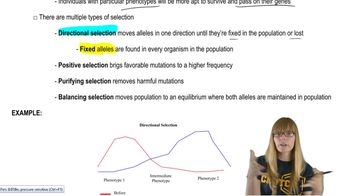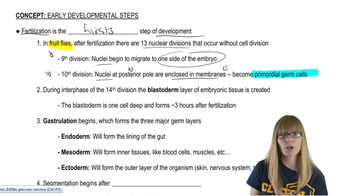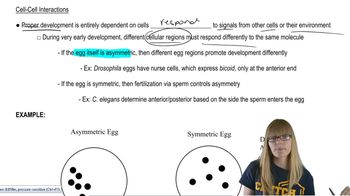Table of contents
- 1. Introduction to Genetics51m
- 2. Mendel's Laws of Inheritance3h 37m
- 3. Extensions to Mendelian Inheritance2h 41m
- 4. Genetic Mapping and Linkage2h 28m
- 5. Genetics of Bacteria and Viruses1h 21m
- 6. Chromosomal Variation1h 48m
- 7. DNA and Chromosome Structure56m
- 8. DNA Replication1h 10m
- 9. Mitosis and Meiosis1h 34m
- 10. Transcription1h 0m
- 11. Translation58m
- 12. Gene Regulation in Prokaryotes1h 19m
- 13. Gene Regulation in Eukaryotes44m
- 14. Genetic Control of Development44m
- 15. Genomes and Genomics1h 50m
- 16. Transposable Elements47m
- 17. Mutation, Repair, and Recombination1h 6m
- 18. Molecular Genetic Tools19m
- 19. Cancer Genetics29m
- 20. Quantitative Genetics1h 26m
- 21. Population Genetics50m
- 22. Evolutionary Genetics29m
14. Genetic Control of Development
Early Developmental Steps
Problem 25
Textbook Question
Dipterans (two-winged insects) are thought to have evolved from a four-winged ancestor that had wings on both T2 and T3 thoracic segments, as in extant butterflies and dragonflies. Describe an evolutionary scenario for the evolution of dipterans from four-winged ancestors. What types of mutations could lead to a butterfly developing with only two wings?
 Verified step by step guidance
Verified step by step guidance1
Identify the ancestral state: Start by understanding that the ancestral state of dipterans likely had four wings, with wings on both the T2 and T3 thoracic segments.
Consider the role of homeotic genes: Homeotic genes, such as the Hox genes, are crucial in determining the identity of body segments. Mutations in these genes can lead to changes in segment identity, potentially transforming a winged segment into a non-winged segment.
Explore possible mutations: A mutation in a Hox gene, such as Ultrabithorax (Ubx), could suppress wing development in the T3 segment, leading to a two-winged phenotype. This mutation could result in the T3 segment developing as a haltere (a small balancing organ) instead of a wing.
Examine evolutionary advantages: Consider the evolutionary advantages of having only two wings. For instance, the development of halteres in place of hindwings in dipterans provides enhanced balance and maneuverability during flight, which could be advantageous for survival and reproduction.
Discuss natural selection: Natural selection would favor individuals with mutations that provide a survival advantage. Over time, the two-winged phenotype could become predominant in the population, leading to the evolution of dipterans from their four-winged ancestors.
Recommended similar problem, with video answer:
 Verified Solution
Verified SolutionThis video solution was recommended by our tutors as helpful for the problem above
Video duration:
3mPlay a video:
Was this helpful?
Key Concepts
Here are the essential concepts you must grasp in order to answer the question correctly.
Evolutionary Adaptation
Evolutionary adaptation refers to the process by which species undergo changes over time to better fit their environment. In the context of dipterans, this could involve modifications in wing structure and function that enhance survival and reproductive success. For example, a reduction in wing size or number may allow for more efficient flight or energy conservation, leading to the eventual dominance of two-winged forms.
Recommended video:
Guided course

Overview
Genetic Mutations
Genetic mutations are changes in the DNA sequence that can lead to variations in physical traits. In butterflies, mutations affecting the development of wings could involve alterations in genes responsible for wing formation, such as those in the Hox gene cluster. These mutations can result in phenotypic changes, such as the loss of wings on one thoracic segment, which may be beneficial under certain environmental conditions.
Recommended video:
Guided course

Mutations and Phenotypes
Natural Selection
Natural selection is the mechanism by which individuals with advantageous traits are more likely to survive and reproduce. In the scenario of dipteran evolution, if two-winged individuals were better adapted to their environment than their four-winged counterparts, they would have a higher chance of passing on their genes. Over generations, this could lead to the prevalence of the two-winged phenotype in the population, illustrating the role of natural selection in evolutionary change.
Recommended video:
Guided course

Natural Selection

 3:46m
3:46mWatch next
Master Drosophilia Development with a bite sized video explanation from Kylia Goodner
Start learningRelated Videos
Related Practice



